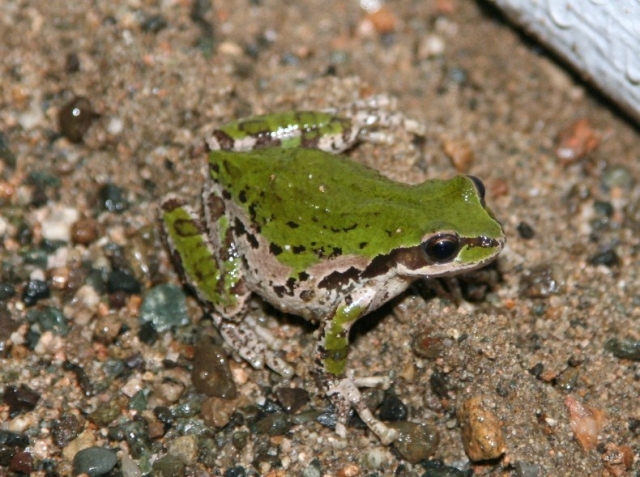A helping hand for hoppers
The modern dating scene might be a perilous one but the modern breeding scene for local frogs, salamanders and toads is just plain deadly.
The Pacific Chorus Frog, the Tiger Salamander, the Long-toed Salamander and the Spadefoot Toad spend their winters among the rocks and trees found in Gilpin Grasslands Provincial Park.
But when the signs of spring like the gentle rains and warmer evening temperatures arrive, these migrating amphibians can’t resist the call of nature, nor the need for the wetlands of Boothman’s Oxbow Provincial Park found alongside the Kettle River, about seven kilometers east of Grand Forks. Those wetlands, which are managed by Ducks Unlimited and whose water levels are maintained for both ducks and amphibian needs, are only accessible to these hoppers by crossing Highway 3.
This migration, which usually occurs between dusk and 11 p.m. in the evening when the conditions are both warm and wet enough, results in a deadly game of Frogger as the amphibians hop and crawl across the wet pavement to get to the breeding grounds. If lucky enough to dodge the crushing tires and arrive at the wetlands, they will mate, lay their eggs or deposit their sperm on the surface of the wetlands before returning to Gilpin for the remainder of the summer.
The Gilpin Boothman’s Oxbow Amphibian Crossing Project takes off
The unnecessary carnage of this migration is what got local biologist Jenny Coleshill, along with the Boundary Habitat Stewards, the Granby Wilderness Society and the Christina Lake Stewardship Society, to start the first ever Gilpin Boothman’s Oxbow Amphibian Crossing Project.
Coleshill, who is the project coordinator, gathered more than 40 volunteers to monitor the migration of the Pacific Chorus Frog, the Tiger Salamander and the Long-toed Salamander and to help these animals cross the road more safely, thereby helping bolster the populations, many of which are dwindling.
“I was most excited about how many other people were so excited about (helping with the migration),” said Coleshill, who loves the conservation side of her job as a biologist.
This past month Coleshill and the volunteers watched the area between Gilpin and Oxbow provincial parks throughout the month of April for signs of the anticipated migration. Coleshill set up catchment fences made of plastic wood wrap donated by Interfor which was weighed down with sand donated by EMCON and spread out by Paul Stone in his quad. The fences, which were only about 18 inches (45 cm) high, were strategically placed between the road and the rock face, where the amphibians are frequently heard or seen.
When the conditions were right, her and her volunteers jumped in to help the frogs cross the road.
The busiest evening happened on Wednesday, April 24. A light drizzle began to fall after a relatively warm spring day, thereby setting the scene for an ideal migration.
The call went out for volunteers, who gathered with anticipation at the Gilpin Grasslands fire service road. Among the eager helpers was Stephanie Gillis with the Ministry of Transporation who enjoyed helping and keeping volunteers safe with reflective vests and headlamps while working alongside the dark highway. Also among the group was Lisa Tedesco, a habitat biologist with the Ministry of Forests, Lands and Natural Resource Operations in Nelson.
When dusk settled the work began.
The volunteers broke up into partners and each group checked one side of the fence line. If a frog or salmander was found, it was recorded and put into a covered bucket to be taken across the road to the wetland. The Long-toed Salamanders who had already mated and were returning back to the Gilpin Grasslands, were lifted over the fence so they could continue their journey home.
The data collected, which Coleshill hopes to continue collecting over the next decade, can be used to monitor the populations and, if any changes happen to the highway, that information will be used by the Ministry of the Environment to help design the road and maybe even include culverts so amphibians will have a safer way to cross.
Alot was learned about the amphibian population that evening. Three Spadefoot Toads were found among the frogs, which was a surprise, said Coleshill. There was also a migration of hundreds of toads along Highway 3 around Whitehall Road. Coleshill also learned that the Long-toed Salamanders seem to breed much earlier than the Pacific Chorus Frogs and during this migration they were returning to the grasslands rather than leaving them. She also discovered that it is not a single migration that happens but one spread over many evenings, depending on how cooperative the weather is.
“The biggest thing about this year was just being there to collect the information which will help us direct activites for next year,” said Coleshill, who plans on monitoring the fall migration of this year’s babies turned adult who will move from the wetlands to the grasslands this fall.
“Tiger Salamanders are a red listed species. To find out more information about them was important but it was a bonus to find out about the Spadefoot toads as well.”
Coleshill was a bit disappointed she didn’t see more Tiger Salamanders and thinks there might be more in a different location, which she’ll explore for next season.
Salmanders at risk in this region
This whole thing began when Coleshill found out there were documented sightings of Tiger Salamanders in the Gilpin Grasslands Provincial Park. While Tiger Salamanders are fairly common on the Canadian Prairies, they are only found in British Columbia between Grand Forks, west to Keremeos and north to Peachland. Most of the B.C. population is found in the Okanagan Valley.
They are one of the few salamanders that are adapted to a desert climate.
“The Tiger Salamander represents two different eco systems — the grasslands and the wetlands,” said Coleshill. “They are an important part of the ecology. They are food for others and they eat things like bugs and mosquitoes. They dig, fertilize and loosen the soil in the grasslands.”
The Tiger Salamander is currently red listed, which means they are at risk of becoming endangered. Habitat loss and wetland loss is one of the big reasons for the declining numbers.
Coleshill, who grew up in the Grand Forks area, fondly remembers rescuing Tiger Salamanders from under her mom’s basement steps, where they would hibernate for the winter. Her mom, Monica Coleshill, lives close to Saddle Lake on Victoria Road in rural Grand Forks.
Saddle Lake used to be a breeding ground for the often secretive and smiling Tiger Salamanders.
“They would be trapped under the basement stairs (after hibernating),” recalls Coleshill. “I would always make contraptions to help them out, but now I’m lucky to see one.”
Coleshill said the population decline is likely due to the introduction of goldfish to the pond. Goldfish eat anything, including tadpoles and salamander eggs therefore destroying the salamander population. The Saddle Lake story is not unlike many others in the area — human caused.
Coleshill hopes by documenting and monitoring all amphibian populations it might help to educate the public about their impact on amphibian habitat.
Coleshill hopes to host some public presentations about the Gilpin Boothman’s Oxbow Amphibian Crossing Project in the future. Stay tuned to the Boundary Sentinel for more details.
For more information about the Tiger Salamander visit http://www.env.gov.bc.ca/okanagan/esd/atlas/species/tiger_salamander.html .
To find out more about the Granby Wilderness Society or to report an animal sighting of the many at risk snakes, grizzly bears and amphibians in this region, please visit their website at www.granbywilderness.ca .



























Comments